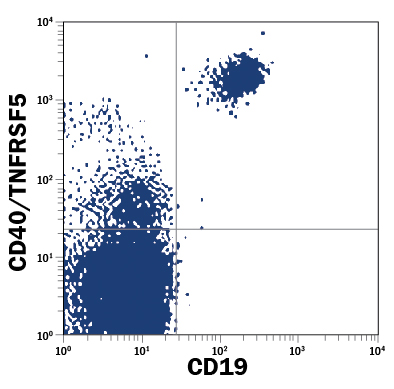Human CD40/TNFRSF5 PE-conjugated Antibody Summary
Glu21-Arg193
Accession # P25942
Applications
Please Note: Optimal dilutions should be determined by each laboratory for each application. General Protocols are available in the Technical Information section on our website.
Scientific Data
 View Larger
View Larger
Detection of CD40/TNFRSF5 in Human Blood Lymphocytes by Flow Cytometry. Human peripheral blood lymphocytes were stained with Mouse Anti-Human CD40/TNFRSF5 PE-conjugated Monoclonal Antibody (Catalog # FAB6321P) and Mouse Anti-Human CD19 Fluorescein-conjugated Monoclonal Antibody (Catalog # FAB4867F). Quadrant markers were set based on control antibody staining (Catalog # IC0041F). View our protocol for Staining Membrane-associated Proteins.
Reconstitution Calculator
Preparation and Storage
Background: CD40/TNFRSF5
CD40, also known as TNFRSF5, is a 45-50 kD type I transmembrane glycoprotein that belongs to the TNF receptor superfamily. Mature human CD40 is 257 amino acids (aa) in length, and consists of a 173 aa extracellular domain (ECD), a 22 aa transmembrane segment and a 62 aa cytoplasmic region. The ECD contains four cysteine-rich repeats, the second of which is considered crucial to ligand binding. Over aa 21-193, human CD40 shares 58% aa sequence identity with mouse CD40. Although not ubiquitously expressed, cells known to constitutively or inducibly express CD40 are large in number and include basal layer keratinocytes, adipocytes, CD8+ T cells, fibrocytes (circulating stem cells), monocytes, eosinophils, dendritic cells, pancreatic duct epithelium, astrocytes, smooth muscle cells, fibroblasts, vascular endothelial cells and B cells. There is at least one alternative splice form that shows a 38 aa substitution for aa 166-277, generating a soluble molecule. There are two "ligands" for CD40, the first being CD154/CD40L, and the second Borrelia, a spirochete that causes Lyme disease. CD40 ligation by CD154 has many outcomes, some of which are cell-specific. Ligation of CD40 on B cells (with IL-4) induces IgE production, while bone marrow stromal cell activation via CD40 promotes OPG secretion with concomitant bone formation. In addition, stimulation of CD40 on keratinocytes results in IL-8 and RANTES expression with subsequent leukocyte infiltration, while adipocyte activation via CD40 promotes local M1 polarization.
Product Datasheets
Citations for Human CD40/TNFRSF5 PE-conjugated Antibody
R&D Systems personnel manually curate a database that contains references using R&D Systems products. The data collected includes not only links to publications in PubMed, but also provides information about sample types, species, and experimental conditions.
2
Citations: Showing 1 - 2
Filter your results:
Filter by:
-
High-content cytometry and transcriptomic biomarker profiling of human B-cell activation.
Authors: Hennig C, Ilginus C, Boztug K, Skokowa J, Marodi L, Szaflarska A, Sass M, Pignata C, Kilic S, Caragol I, Baumann U, Klein C, Welte K, Hansen G
J Allergy Clin Immunol, 2013-09-05;133(1):172-80.e1-10.
Species: Human
Sample Types: Whole Cells
Applications: Chip Cytometry -
Oxidation of ovarian epithelial cancer cells by hypochlorous acid enhances immunogenicity and stimulates T cells that recognize autologous primary tumor.
Authors: Chiang CL, Ledermann JA, Aitkens E, Benjamin E, Katz DR, Chain BM
Clin. Cancer Res., 2008-08-01;14(15):4898-907.
Species: Human
Sample Types: Whole Cells
Applications: Flow Cytometry
FAQs
No product specific FAQs exist for this product, however you may
View all Antibody FAQsReviews for Human CD40/TNFRSF5 PE-conjugated Antibody
There are currently no reviews for this product. Be the first to review Human CD40/TNFRSF5 PE-conjugated Antibody and earn rewards!
Have you used Human CD40/TNFRSF5 PE-conjugated Antibody?
Submit a review and receive an Amazon gift card.
$25/€18/£15/$25CAN/¥75 Yuan/¥2500 Yen for a review with an image
$10/€7/£6/$10 CAD/¥70 Yuan/¥1110 Yen for a review without an image



